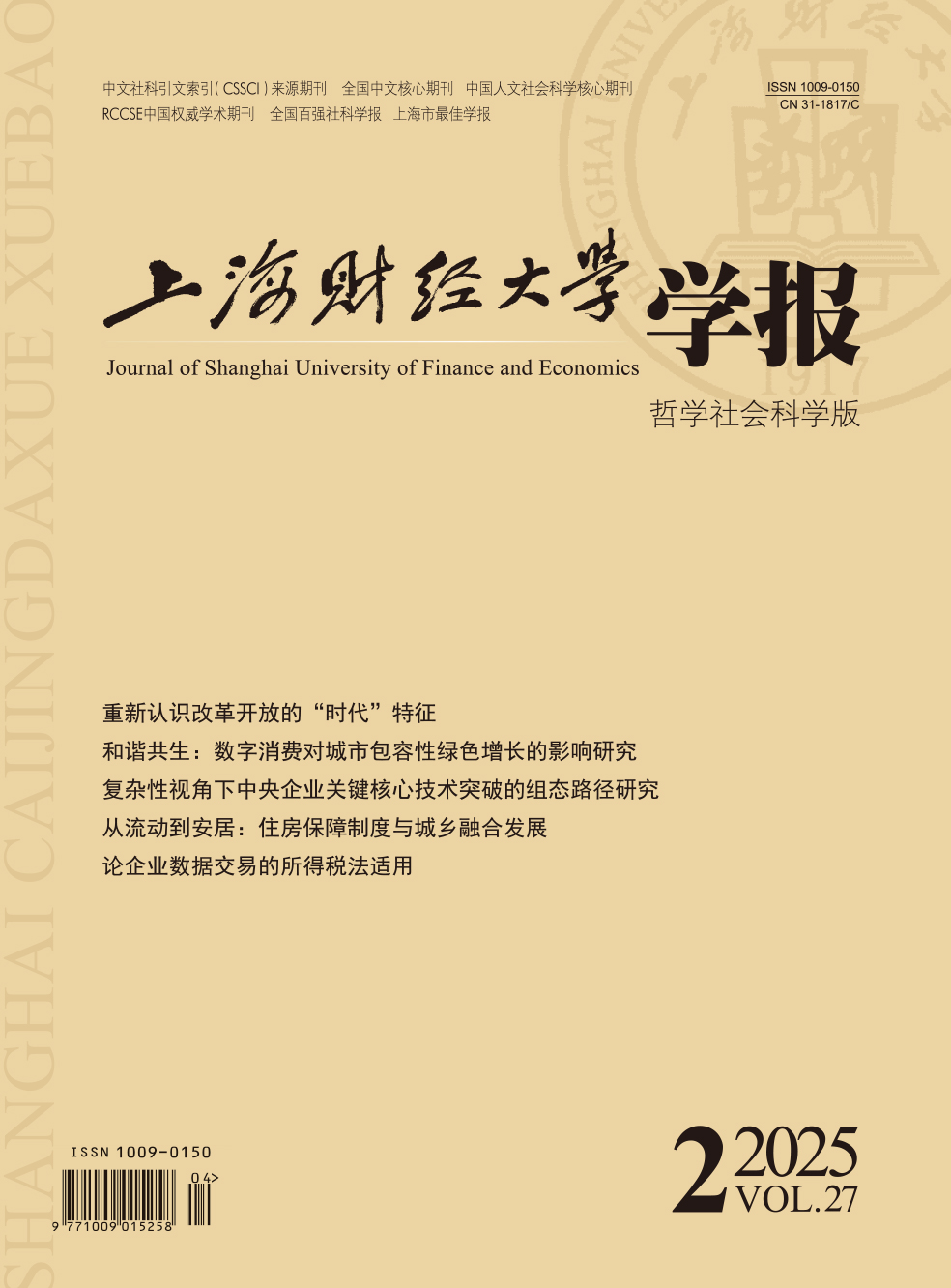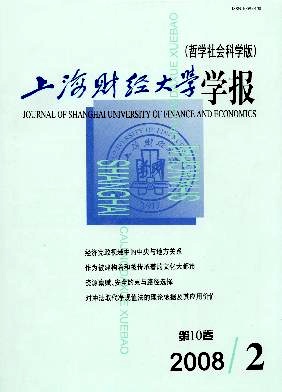财政政策的凯恩斯效应与非凯恩斯效应
上海财经大学学报 2008 年 第 10 卷第 02 期, 页码:65 - 72
摘要
参考文献
摘要
本文基于财政政策的经典文献,从凯恩斯总收支模型出发,通过不断放宽其假设条件对稳定性财政政策可能出现的凯恩斯效应、需求中性效应以及非凯恩斯效应进行了归纳,在此基础上对三种效应的相关研究文献进行了评述。研究认为,尽管稳定性财政政策宏观调控的长短期效应还存在很大分歧,但并不表明,财政政策不可以充当稳定经济的角色,相反,分歧只能说明稳定性财政政策有效性需要一定的条件。这一结论对特定条件下财政政策的制定及其可能效应的事前预测具有非常重要的意义。
②对Lerner的“功能财政”思想的详细考察可以参见Lerner(1943,1961)。对债务负担争论的经典总结可以参见Ferguson(1964)、Tobin(1965)。
③Hansen(1941)提出虽然“汲水政策”和“补偿性财政政策”的目的都是使经济处于潜在产出水平状态,但两者存在很大的区别,前者是政府根据“汲水”原理,在不同的条件下,通过向经济注入一定数量的公共支出使经济恢复到依靠自身的能力达到一种资源充分利用状态。后者只是根据私人部门需求的下降,利用财政支出进行补偿,至于这种补偿能否是经济复苏或恢复到充分就业状态并不是问题的关键。实际上,Hansen提出这两种政策,就持续的时间而言,前者只是一种临时性的政策,依靠的是经济中的“乘数”机制,后者在持续时间上没有一个明确的界定,并且不是依靠“乘数”机制。
④参见Robert J.Barro,are government bonds net wealth?Journal of Political Economy,vol.82,1974。
⑥Buchanan和Seater对Barro关于该命题的研究进行过细致的讨论,参见Buchanan(1976)、Seater(1993)。
⑦然而,上述分析并不意味着,财政政策作为一个整体其效应是中性的,这取决于政府资源使用的水平。具体分析可以参阅Seater(1993),Barro(1989)。
⑨传统凯恩斯学派也对预期非常重视,这一点可以参见凯恩斯的《通论》第十二章。
10Joanna Si winska&Piotr Bujak(2003)对上述四个模型进行过比较和检验。
[1]凯恩斯.就业、利息和货币通论[M].高鸿业译,北京:商务印书馆,2004.
[2]Alan S.Blinder and Robert M.Solow.Does fiscal policy matter?[J].Journal of Public Economics,vol.2,1973.
[3]Alan Sutherland.Fiscal crises and aggregate demand:can high public debt reverse the effects of fiscal poli-cy?[J].Journal of Public Economics,vol.65,1997.
[4]Aschauer David.Fiscal policy and aggregate demand[J].American Economic Review,vol.75,1985.
[5]Franco Modigliani.The life cycle hypothesis of saving[J].American Economic Review,1963.
[6]Finn E.Kydland and Edward C.Prescott.Rules rather than discretion:the inconsistency of opti mal plans[J].Journal of Political Economy,vol.85,1977.
[7]Giavazzi F.,Japelli T.and Pagano M..Searching for non-linear effects of fiscal policy:evidence fromin-dustrial and developing countries[R].NBER Working Paper no.7460,2000.
[8]Gregory N.Manki w.Small menu costs and large business cycles:a macroeconomic model of monopoly[J].Querterly Journal of Economics,vol.100,1985.
[9]George A.Akerlof and Janet L Yellen.Anear-rational model of the business cycle with wage and priceiner-tia[J].Querterly Journal of Economics,vol.100,1985.
[10]Giuseppe Bertola and Allan Drazen.Trigger points and budget cuts:explaining the effects of fiscal austeri-ty[J].American Economic Review,vol.83,1993.
[11]James Tobin.Inflation and unemployment[J].American Economic Review,vol.62,1972.
[12]John B.Taylor.Aggregate dynamics and staggered contracts[J].Journal of Political Economy,vol.88,1980.
[13]Lucas Robert E.Jr.Some international evidence on output-inflation tradeoffs:reply[J].American Eco-nomic Review,vol.67(4),1977.
[14]Martin Feldstein.Government deficits and aggregate demand[J].Journal of Monetary Economics,vol.9(1),1982.
[15]Milton Friedman.The role of monetary policy[J].American Economic Review,vol.1(17),1968.
[16]Olivier Blanchard.Comment on“Can severe fiscal contractions be expansionary?”[R].NBER Macroeco-nomics Annual,1990.
[17]Roberto Perotti.Fiscal policy in good ti mes and bad[J].Quarterly Journal of Economies,1999.
[18]Robert J.Barro.Government spending in a si mple model of endogenous growth[J].Journal of Political E-conomy,vol.98,1990.
[19]Roger C.Kormendi.Government debt,government spending,and private sector behavior[J].American E-conomic Review,vol.73(5),1983.
[20]Russell Cooper and John Andrew.Coordinating coordination failures in Keynesian models[J].QuarterlyJournal of Economics,vol.103,1988.
③Hansen(1941)提出虽然“汲水政策”和“补偿性财政政策”的目的都是使经济处于潜在产出水平状态,但两者存在很大的区别,前者是政府根据“汲水”原理,在不同的条件下,通过向经济注入一定数量的公共支出使经济恢复到依靠自身的能力达到一种资源充分利用状态。后者只是根据私人部门需求的下降,利用财政支出进行补偿,至于这种补偿能否是经济复苏或恢复到充分就业状态并不是问题的关键。实际上,Hansen提出这两种政策,就持续的时间而言,前者只是一种临时性的政策,依靠的是经济中的“乘数”机制,后者在持续时间上没有一个明确的界定,并且不是依靠“乘数”机制。
④参见Robert J.Barro,are government bonds net wealth?Journal of Political Economy,vol.82,1974。
⑥Buchanan和Seater对Barro关于该命题的研究进行过细致的讨论,参见Buchanan(1976)、Seater(1993)。
⑦然而,上述分析并不意味着,财政政策作为一个整体其效应是中性的,这取决于政府资源使用的水平。具体分析可以参阅Seater(1993),Barro(1989)。
⑨传统凯恩斯学派也对预期非常重视,这一点可以参见凯恩斯的《通论》第十二章。
10Joanna Si winska&Piotr Bujak(2003)对上述四个模型进行过比较和检验。
[1]凯恩斯.就业、利息和货币通论[M].高鸿业译,北京:商务印书馆,2004.
[2]Alan S.Blinder and Robert M.Solow.Does fiscal policy matter?[J].Journal of Public Economics,vol.2,1973.
[3]Alan Sutherland.Fiscal crises and aggregate demand:can high public debt reverse the effects of fiscal poli-cy?[J].Journal of Public Economics,vol.65,1997.
[4]Aschauer David.Fiscal policy and aggregate demand[J].American Economic Review,vol.75,1985.
[5]Franco Modigliani.The life cycle hypothesis of saving[J].American Economic Review,1963.
[6]Finn E.Kydland and Edward C.Prescott.Rules rather than discretion:the inconsistency of opti mal plans[J].Journal of Political Economy,vol.85,1977.
[7]Giavazzi F.,Japelli T.and Pagano M..Searching for non-linear effects of fiscal policy:evidence fromin-dustrial and developing countries[R].NBER Working Paper no.7460,2000.
[8]Gregory N.Manki w.Small menu costs and large business cycles:a macroeconomic model of monopoly[J].Querterly Journal of Economics,vol.100,1985.
[9]George A.Akerlof and Janet L Yellen.Anear-rational model of the business cycle with wage and priceiner-tia[J].Querterly Journal of Economics,vol.100,1985.
[10]Giuseppe Bertola and Allan Drazen.Trigger points and budget cuts:explaining the effects of fiscal austeri-ty[J].American Economic Review,vol.83,1993.
[11]James Tobin.Inflation and unemployment[J].American Economic Review,vol.62,1972.
[12]John B.Taylor.Aggregate dynamics and staggered contracts[J].Journal of Political Economy,vol.88,1980.
[13]Lucas Robert E.Jr.Some international evidence on output-inflation tradeoffs:reply[J].American Eco-nomic Review,vol.67(4),1977.
[14]Martin Feldstein.Government deficits and aggregate demand[J].Journal of Monetary Economics,vol.9(1),1982.
[15]Milton Friedman.The role of monetary policy[J].American Economic Review,vol.1(17),1968.
[16]Olivier Blanchard.Comment on“Can severe fiscal contractions be expansionary?”[R].NBER Macroeco-nomics Annual,1990.
[17]Roberto Perotti.Fiscal policy in good ti mes and bad[J].Quarterly Journal of Economies,1999.
[18]Robert J.Barro.Government spending in a si mple model of endogenous growth[J].Journal of Political E-conomy,vol.98,1990.
[19]Roger C.Kormendi.Government debt,government spending,and private sector behavior[J].American E-conomic Review,vol.73(5),1983.
[20]Russell Cooper and John Andrew.Coordinating coordination failures in Keynesian models[J].QuarterlyJournal of Economics,vol.103,1988.
引用本文
李永友. 财政政策的凯恩斯效应与非凯恩斯效应[J]. 上海财经大学学报, 2008, 10(2): 65–72.
导出参考文献,格式为:





 6068
6068  713
713

